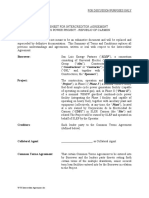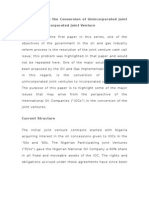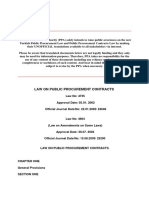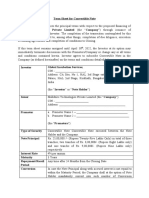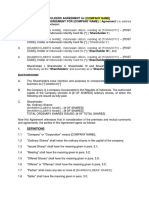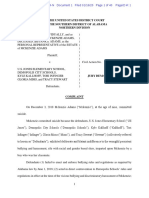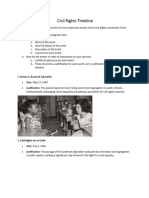100%(1)100% found this document useful (1 vote)
808 viewsAbu Dhabi 2007 Form of Contract - Article
Abu Dhabi 2007 Form of Contract - Article
Uploaded by
Mahesh ButaniThe document discusses new construction contracts issued by the Abu Dhabi government that are based on FIDIC 1999 forms but contain some amendments. While generally maintaining FIDIC principles, the amendments impose harsher obligations on contractors and relieve employers of some responsibilities. Contractors should carefully review the contracts before signing to understand changes from standard FIDIC forms.
Copyright:
© All Rights Reserved
Available Formats
Download as PDF, TXT or read online from Scribd
Abu Dhabi 2007 Form of Contract - Article
Abu Dhabi 2007 Form of Contract - Article
Uploaded by
Mahesh Butani100%(1)100% found this document useful (1 vote)
808 views2 pagesThe document discusses new construction contracts issued by the Abu Dhabi government that are based on FIDIC 1999 forms but contain some amendments. While generally maintaining FIDIC principles, the amendments impose harsher obligations on contractors and relieve employers of some responsibilities. Contractors should carefully review the contracts before signing to understand changes from standard FIDIC forms.
Original Description:
Commentary on the Abu Dhabi Standard Form of Construction Contract 2007
Original Title
Abu Dhabi 2007 form of Contract - Article
Copyright
© © All Rights Reserved
Available Formats
PDF, TXT or read online from Scribd
Share this document
Did you find this document useful?
Is this content inappropriate?
The document discusses new construction contracts issued by the Abu Dhabi government that are based on FIDIC 1999 forms but contain some amendments. While generally maintaining FIDIC principles, the amendments impose harsher obligations on contractors and relieve employers of some responsibilities. Contractors should carefully review the contracts before signing to understand changes from standard FIDIC forms.
Copyright:
© All Rights Reserved
Available Formats
Download as PDF, TXT or read online from Scribd
Download as pdf or txt
100%(1)100% found this document useful (1 vote)
808 views2 pagesAbu Dhabi 2007 Form of Contract - Article
Abu Dhabi 2007 Form of Contract - Article
Uploaded by
Mahesh ButaniThe document discusses new construction contracts issued by the Abu Dhabi government that are based on FIDIC 1999 forms but contain some amendments. While generally maintaining FIDIC principles, the amendments impose harsher obligations on contractors and relieve employers of some responsibilities. Contractors should carefully review the contracts before signing to understand changes from standard FIDIC forms.
Copyright:
© All Rights Reserved
Available Formats
Download as PDF, TXT or read online from Scribd
Download as pdf or txt
You are on page 1of 2
FIDIC 1999 or something else in disguise?
Page 1 of 2
FIDIC 1999 or something else in disguise?
Michelle Nelson , June 29th, 2007
Contractors already working in or thinking of working in the UAE capital may be
aware that the Abu Dhabi government has recently issued new contracts for
construction projects being undertaken in the emirate on behalf of public entities.
The word on the street is that these contracts are to be welcomed since it is
perceived that the Abu Dhabi government has decided to adopt the FIDIC 1999
form of contract.
However, how many of you have studied these contracts in any detail? Are you
aware, for example, of the type and extent of the changes that have been made to
the standard FIDIC forms in these new contracts? This article will explore some of the key features of the FIDIC forms and
highlight a number of the interesting amendments made in the new Abu Dhabi contracts.
The good news is that these contracts, in general terms, maintain the principle features of the FIDIC 1999 forms of contract.
The new Abu Dhabi contracts were introduced by Law No. 21 of 2006 and copies were attached to Executive Decision No. 1 of
2007, bringing them into force. There are two forms of contract: Build Only and Design and Build. These contracts replace the
earlier General Conditions of Contract adopted by government departments in Abu Dhabi and are applicable for all civil
construction works entered into by government departments in Abu Dhabi. They do not, however, apply to the private developers
such as Sorouh, Aldar and Al Qudra, who remain free to adopt whatever forms of contract they wish.
The good news is that these contracts, in general terms, maintain the principle features of the FIDIC 1999 forms of contract,
which were introduced to counter the growing criticism from the international contracting community in relation to the old forms
of contract, and in particular the FIDIC 1987 Red Book 4th Edition. For example, we now have the introduction of the dispute
adjudication board and the erosion of some of the power previously given to the engineer, new provisions in relation to design,
worked-up clauses in relation to variations, claims and payment and an optional clause allowing the contractor to claim for price
escalation.
The not-so-good news for contractors operating on these new forms, however, is that there are many subtle changes from the
FIDIC 1999 forms of contract, which seek to impose harsher obligations upon the contractor and relieve the employer from some
of the "balancing obligations" that FIDIC had deliberately put in place to provide an even risk allocation between the parties. It is
these changes, which contractors entering into these contracts should be aware of and ensure they have priced, as far as
possible.
One of the most notable amendments is found in the Design and Build form, which is based upon the FIDIC Yellow Book. One of
the basic philosophies of the FIDIC Design and Build contract is that the employer will retain responsibility for both the
correctness of information provided to the contractor by the employer as well as the correctness of the employer's requirements.
Furthermore, the employer also takes the risk of unforeseen physical conditions. As such, to the extent that errors are discovered
in the information provided by the employer or unforeseen physical conditions are discovered to exist, the contractor will be
entitled to an extension of time and additional costs. The provisions providing such remedies have, however, been completely
deleted in the new Abu Dhabi contracts and what's more, there is an express provision which confirms that the contractor will
assume responsibility for any design prepared by the employer - irrespective of whether it contains errors!
Another example of an amendment in the Abu Dhabi contracts is the addition of a new clause which provides a list of warranties
to be given by the contractor, over and above the general obligations found in the standard form of contract. A further change is
that the cap on liquidated damages for delay has been increased from the standard 10% generally provided in this region to 20%
of the contract sum. This could clearly be extremely substantial in many contracts worth significant sums of money.
In relation to termination, while the employer has the ability to terminate the contract on 14 days' notice, the contractor has to
follow a series of steps, including referral of the issue to the dispute board, before it is entitled to terminate - the culmination of
which means that it has to wait for a period of 132 days from the event/breach in question before it can terminate the contract!
Again, a good example of the "balance" of power between the parties!
There are many more examples of changes - some of which are subtle, some are not. The message to contractors entering into
contracts on the basis of these forms is to review them very carefully before signing. Do not be fooled into thinking they are
simply the FIDIC 1999 Red and Yellow books with a few tweaks.
http://www.constructionweekonline.com/article-1047-fidic-1999-or-something-else-in... 11/01/2015
FIDIC 1999 or something else in disguise?
Page 2 of 2
2015 ITP Business Publishing Ltd. | Use of this site content constitutes acceptance of our User Policy, Privacy Policy and Terms & Conditions.
http://www.constructionweekonline.com/article-1047-fidic-1999-or-something-else-in... 11/01/2015
You might also like
- Investing in Professional Sports LeaguesDocument39 pagesInvesting in Professional Sports LeaguesWilliane MartinsNo ratings yet
- Term Sheet For Intercreditor Agreement 1.21Document4 pagesTerm Sheet For Intercreditor Agreement 1.21Helpin HandNo ratings yet
- Of Counsel Agreement FYIDocument2 pagesOf Counsel Agreement FYIAnonymous v3dT7UF0% (1)
- General Contract Template - Import of Goods: Asala Honey LLC (Approved by The Board 03 October 2020)Document4 pagesGeneral Contract Template - Import of Goods: Asala Honey LLC (Approved by The Board 03 October 2020)Pcelin OtrovNo ratings yet
- Software Product Development A Complete Guide - 2020 EditionFrom EverandSoftware Product Development A Complete Guide - 2020 EditionNo ratings yet
- Co-Tutorship Bilateral AgreementDocument2 pagesCo-Tutorship Bilateral AgreementDanieleNo ratings yet
- Contracts Under Qatari LawDocument2 pagesContracts Under Qatari LawJake ElwoodNo ratings yet
- Content Provider Agreement LearnographDocument6 pagesContent Provider Agreement LearnographAnonymous RxWzgONo ratings yet
- Equity Commitment LetterDocument59 pagesEquity Commitment LetteralecNo ratings yet
- Paper 4 - The Incorporated Joint Venture Structure As A Panacea To Cash Call IssuesDocument7 pagesPaper 4 - The Incorporated Joint Venture Structure As A Panacea To Cash Call IssuesAdeoye AdefuluNo ratings yet
- Jointventurechecklist 0Document7 pagesJointventurechecklist 0chikondifbNo ratings yet
- Memorandum of Understanding: BetweenDocument3 pagesMemorandum of Understanding: BetweenEdrich Lito GomezNo ratings yet
- MoU, Legal Nature DraftingDocument12 pagesMoU, Legal Nature Draftingsuperandroid21No ratings yet
- Seedsummit HK Founder Collaboration Agreement FINALDocument3 pagesSeedsummit HK Founder Collaboration Agreement FINALАнна СоколоваNo ratings yet
- Expert Determination Clauses in Contracts Providing For International ArbitrationDocument6 pagesExpert Determination Clauses in Contracts Providing For International ArbitrationJúlia de MarckNo ratings yet
- Framework Agreement On Work-Related StressDocument97 pagesFramework Agreement On Work-Related StressJoaquín Vicente Ramos RodríguezNo ratings yet
- Public Procurement Contracts LawDocument17 pagesPublic Procurement Contracts Lawbbking44No ratings yet
- Greece - EFSF Master Financial Facility Agreement 2012Document68 pagesGreece - EFSF Master Financial Facility Agreement 2012Yannis KoutsomitisNo ratings yet
- Capital Waters Convertible Loan Agreement.2.1 (UK) 30-5-2016Document7 pagesCapital Waters Convertible Loan Agreement.2.1 (UK) 30-5-2016Charlie PhillipsNo ratings yet
- Sample Employment AgreementDocument8 pagesSample Employment AgreementNational Association of REALTORS®No ratings yet
- Force Majeure Clause - FIDIC - APQS AssignmentDocument3 pagesForce Majeure Clause - FIDIC - APQS Assignmentratneshtripathi1412No ratings yet
- Exit Options in Equity Investments in India Recent Issues On LegalityDocument17 pagesExit Options in Equity Investments in India Recent Issues On Legalityadikool2006No ratings yet
- Development Bank: Page - 1Document2 pagesDevelopment Bank: Page - 1Samira Islam100% (1)
- Force Majeure Clause in Aviation Industry ContractsDocument6 pagesForce Majeure Clause in Aviation Industry ContractsYash TyagiNo ratings yet
- Agreement For Sale of A Plot in A Development Layout: Form No. 5Document3 pagesAgreement For Sale of A Plot in A Development Layout: Form No. 5Sudeep SharmaNo ratings yet
- 1493033051wpdm - Loan Agreement Template 04Document4 pages1493033051wpdm - Loan Agreement Template 04diana jane mayuga100% (1)
- 2015 Jurisdiction ChallengesDocument38 pages2015 Jurisdiction Challengesfaaderinto5964No ratings yet
- LiborDocument4 pagesLiborDaisy AggarwalNo ratings yet
- Deed of SuretyDocument6 pagesDeed of SuretyKobus MyburgNo ratings yet
- Real Estate Buyer Non Disclosure AgreementDocument2 pagesReal Estate Buyer Non Disclosure AgreementVince Sanchez100% (1)
- loanAgreementV3 EirDocument14 pagesloanAgreementV3 EirtyroneoviedoNo ratings yet
- Master Framework AgreementDocument195 pagesMaster Framework Agreementtimbittim97No ratings yet
- PARTNERSHIP AGREEMENT v2Document13 pagesPARTNERSHIP AGREEMENT v2utama999No ratings yet
- Acquisition AgreementDocument2 pagesAcquisition AgreementKimseonghyunNo ratings yet
- Tripartite Agreement (Builder Subvention Facilities)Document6 pagesTripartite Agreement (Builder Subvention Facilities)Harsh GuptaNo ratings yet
- Production Sharing Agreements: Oil Privatisation by Another NameDocument16 pagesProduction Sharing Agreements: Oil Privatisation by Another NameProtect Florida's BeachesNo ratings yet
- Warranties Construction ContractsDocument4 pagesWarranties Construction ContractsAbdelmajid WildHunter FisherNo ratings yet
- Force Majeure ClausesDocument20 pagesForce Majeure Clauseshuangpeter55No ratings yet
- Chemexon Draft Mou July 2021Document9 pagesChemexon Draft Mou July 2021Forward AbinalNo ratings yet
- Mutual NdaDocument4 pagesMutual NdaedallmightyNo ratings yet
- Services and Goods ContractDocument25 pagesServices and Goods ContractShachi Pandey TripathiNo ratings yet
- Qatar PDFDocument11 pagesQatar PDFdenyfateNo ratings yet
- Term Sheet - Convertible Note - SkillDzireDocument5 pagesTerm Sheet - Convertible Note - SkillDzireMAツVIcKYツNo ratings yet
- Side Letter To SEIU-UHW's Secret Deal With The California Hospital Association: May 5, 2014Document1 pageSide Letter To SEIU-UHW's Secret Deal With The California Hospital Association: May 5, 2014Anonymous iC9QziKNo ratings yet
- C.4 Guaranteed Maximum Price (June 2014)Document10 pagesC.4 Guaranteed Maximum Price (June 2014)Jose NavarroNo ratings yet
- Detailed Guidelines On Use of Framework AgreementsDocument7 pagesDetailed Guidelines On Use of Framework AgreementsFreddy VargasNo ratings yet
- Forms of Employment in Poland PDFDocument14 pagesForms of Employment in Poland PDFJames CarterNo ratings yet
- Export Credit Insurance Policy PDFDocument2 pagesExport Credit Insurance Policy PDFBrianNo ratings yet
- Exclusive Negotiations AgreementDocument17 pagesExclusive Negotiations AgreementLavanya Ramakrishnan100% (1)
- Draft Concession Agrement VISL PDFDocument295 pagesDraft Concession Agrement VISL PDFDshNo ratings yet
- Shareholders Agreement For (Company Name)Document10 pagesShareholders Agreement For (Company Name)YonastanNo ratings yet
- Purchasing Agency AgreementDocument4 pagesPurchasing Agency AgreementSkip ZulickNo ratings yet
- Forbearance AgreementDocument4 pagesForbearance Agreementsoniasosa01100% (1)
- Article of AssociationDocument19 pagesArticle of AssociationDhruvraj SolankiNo ratings yet
- Law No (22) of 2004 Regarding Promulgating The Civil CodeDocument372 pagesLaw No (22) of 2004 Regarding Promulgating The Civil CodeTomoe GozenNo ratings yet
- Template Convertible Loan Short Form 1Document11 pagesTemplate Convertible Loan Short Form 1bie_kingNo ratings yet
- Sample CADocument3 pagesSample CAVita DepanteNo ratings yet
- Contract 17 - Roles and Responsibilities Within ProjectsDocument17 pagesContract 17 - Roles and Responsibilities Within ProjectsRUMMNo ratings yet
- HttpsDocument4 pagesHttpsDamith FernandoNo ratings yet
- Application Form: Jaipur - 302 005Document3 pagesApplication Form: Jaipur - 302 005p4pajiNo ratings yet
- Martin Luther KingDocument8 pagesMartin Luther Kingapi-437292599100% (1)
- 2014rev MS100Document3 pages2014rev MS100younusbasha143No ratings yet
- 029 SLLR SLLR 1993 1 AMARATUNGA v. SIRIMAL AND OTHERS JANA GHOSHA CASEDocument9 pages029 SLLR SLLR 1993 1 AMARATUNGA v. SIRIMAL AND OTHERS JANA GHOSHA CASEBinendriNo ratings yet
- Perry Wrong To Say Texas' Equal Pay Act Duplicates Federal LawDocument2 pagesPerry Wrong To Say Texas' Equal Pay Act Duplicates Federal LawProgressTXNo ratings yet
- Deed of Donation Inter Vivos - Building Naman (Lao)Document2 pagesDeed of Donation Inter Vivos - Building Naman (Lao)YsabelleNo ratings yet
- McKenzie Adams Suicide LawsuitDocument40 pagesMcKenzie Adams Suicide LawsuitNational Content Desk100% (2)
- Aralin Panlipunan Ans KeyDocument2 pagesAralin Panlipunan Ans KeyAsaneszz SideñoNo ratings yet
- Creative Research Project Pamphlet ExampleDocument2 pagesCreative Research Project Pamphlet Exampleapi-642237718No ratings yet
- Practice 29Document10 pagesPractice 29phuongdtnNo ratings yet
- Children's Hospital Okland, Dec. 30, 2013 McMath Civil Rights Lawsuit FilingDocument75 pagesChildren's Hospital Okland, Dec. 30, 2013 McMath Civil Rights Lawsuit FilingBetsy A. Ross100% (1)
- Kerri Ray Lawsuit and ComplaintDocument21 pagesKerri Ray Lawsuit and ComplaintIsland Packet and Beaufort GazetteNo ratings yet
- Indianarmy - Nic.in Site Rti Rti MML MML Volume 3 ChapterDocument2 pagesIndianarmy - Nic.in Site Rti Rti MML MML Volume 3 ChapterShankar RaiNo ratings yet
- Wezesha Scholarship Application FormDocument5 pagesWezesha Scholarship Application Formberyl achiengNo ratings yet
- Volume 46, Issue 46, November 13, 2015Document39 pagesVolume 46, Issue 46, November 13, 2015BladeNo ratings yet
- Sample Syllabus ComparisonDocument15 pagesSample Syllabus ComparisonJocel Elid EspinolaNo ratings yet
- Analyzing Literature: Self-Learning KitDocument21 pagesAnalyzing Literature: Self-Learning KitPrincess Loraine Duyag100% (1)
- Essay 2 - Living ConstitutionDocument4 pagesEssay 2 - Living Constitutionapi-251240284No ratings yet
- Fidelio Winter 1992Document88 pagesFidelio Winter 1992Joseph MagilNo ratings yet
- Maximizing Information's Freedom: The Nuts, Bolts & Levers of FOIADocument38 pagesMaximizing Information's Freedom: The Nuts, Bolts & Levers of FOIAJ CoxNo ratings yet
- South African Apartheid and The Transition To Democracy PDFDocument10 pagesSouth African Apartheid and The Transition To Democracy PDFChuma7470% (1)
- Human Rights NotesDocument14 pagesHuman Rights NotesSapna SharmaNo ratings yet
- Sources. Ed. K. Lee Lerner, Brenda Wilmoth Lerner, and Adrienne Lerner. Detroit: GaleDocument4 pagesSources. Ed. K. Lee Lerner, Brenda Wilmoth Lerner, and Adrienne Lerner. Detroit: Galetarin15No ratings yet
- USD263856 Klingon D-7 Design PatentDocument3 pagesUSD263856 Klingon D-7 Design PatentfuccioniNo ratings yet
- GB Road Brothel Story.Document2 pagesGB Road Brothel Story.Danish KhanNo ratings yet
- Indivisibility of Human RightsDocument14 pagesIndivisibility of Human RightsElena Dimitra PantopoulouNo ratings yet
- Regarding Marginal Open Space While Granting Additional 0.5 FSIDocument2 pagesRegarding Marginal Open Space While Granting Additional 0.5 FSIVijay BarangleNo ratings yet
- Jim Crow Laws-Facts 1Document8 pagesJim Crow Laws-Facts 1Rocio Ayelén Pérez NuñezNo ratings yet
- Starwars Atlas AppendixDocument122 pagesStarwars Atlas AppendixGensai Kawakami100% (1)
- Civil Rights TimelineDocument6 pagesCivil Rights TimelineSiddhaant JainNo ratings yet

